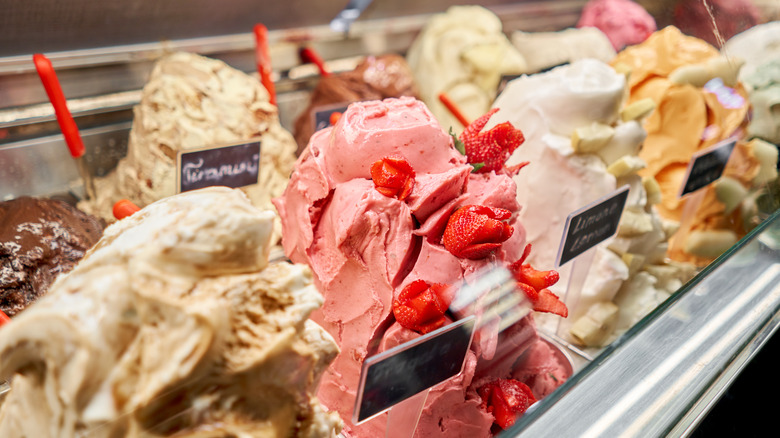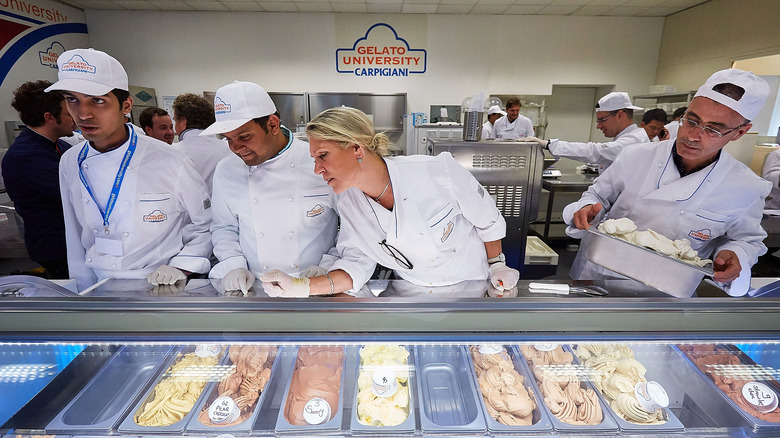The Untold Truth Of Gelato
Gelato is fun, refreshing, and delightful — but it's also very serious. (But then again, so is most food to Italians.) Quality ingredients and centuries of tradition go into each cup and cone of this frozen Italian treat, and there is a definitive list of do's and don'ts when it comes to authenticity. There is a certain process to make it, a specific method to serve it, and even a manner in which to order it.
To a casual consumer or tourist, gelato may just be a delicious dessert. Others, however, have built and continue to build their lives around it, researching, studying, and even competing for glory in high stakes international competitions. For these people, gelato isn't just Italian ice cream, but a unique dessert with its own rich and colorful history. And while it may be Italian, chefs all around the world have been enraptured by its sweet simplicity.
Gelato was originally only for nobles
According to Italy Magazine, the precursor to Italian gelato was an icy Arabic drink flavored with sugar syrup. Eventually, the dessert made its way to Sicily in the 9th century, when the Arabs left nearby North Africa to conquer the southern Italian island.mWhile the concept of a frozen treat had already made it to Italian lands, it wasn't until several hundred years later that Italian alchemist Cosimo Ruggieri whipped up the first gelato.
Per Italy Magazine, Ruggieri kept the flavor and ingredients simple, making fior di latte for the highly influential House of Medici in Renaissance-era Florence, using milk, sugar, and cream. Shortly afterward, an architect named Bernardo Buontalenti added eggs to the recipe. During this time, gelato was a luxury to which only wealthy nobles had access, and the general public only received access to it in the 17th century. Most people who enjoy gelato as a common street dessert today would never have been able to eat it when it first came about!
The world's first gelato cafe was launched in France, not Italy
While it was an Italian who invented gelato, and another Italian (fittingly, a Sicilian) who introduced it to the common man, the world's first gelato shop was not established in Italy. Italy Magazine writes that Francesco Procopio Cutò of Sicily launched the very first gelateria, Café Le Procope, in Paris in 1686.
Cutò's success was due in part to the fact that he had perfected his grandfather's gelato machine per Sicilian Post, which made it easier to produce the delectable dessert on a larger scale. Café Le Procope was a favorite haunt among French intellectuals and writers, including the famous philosopher Rousseau. Today, it is still going strong and can call itself the oldest café in Paris! And while the menu now focuses on traditional French cuisine, there is still an extensive list of crèmes glacées et sorbets artisanaux (ice creams and artisanal sorbets).
There is a Gelato University
Some people go to school to study architecture, finance, or literature, but others make it their mission to study gelato-making. Carpigiani Gelato University's main campus can be found just outside the Italian food capital of Bologna. Carpigiani has been producing top-of-the-line gelato machines for decades, and in 2003, they were inspired to take their dedication to the dessert even further. The company founded a school, inviting the world's best gelato chefs to instruct those eager to learn the craft.
While the main campus offers basic to advanced level courses in multiple languages and attracts many international students, Gelato University has expanded to become a global institution. Satellite campuses can be found on most continents, including Asia and South America. All in all, the school attracts approximately 4,000 students per year, and according to Italy Magazine, the students' ages range from 35 to 40 years old. That means that many of them are seeking a big career and life change by following their passion for gelato, which is truly inspiring!
There is a Gelato World Cup — and Italy has lost a few
Once students have graduated Gelato University and become masters themselves, they are often keen to show off their skills. To feed this need, the best gelato chefs around the world can sign up for international competitions such as the Gelato World Cup. Yes, it sounds made up, but it's actually a legitimate and surprisingly fierce competition!
The Gelato World Cup is hosted by Sigep, and it is one arena of The Dolce World Expo, an international trade fair. (Other areas of competition include pastry, coffee, and bakery.) Just like with sports events, teams of professional gelato chefs must make it through various qualifying rounds to earn a spot at the Gelato World Cup.
Even though gelato is Italian in origin, Italian teams have not always won this major competition. In fact, they have lost several times to France; France has taken first place four times, while Italy has won the title five times. Previous second and third place teams include Spain, Argentina, Switzerland, Belgium, Poland, Morocco, Australia, and Japan.
Gelato is healthier than ice cream — maybe even performance enhancing
So everybody wants to know: What is the difference between gelato and ice cream? While both iconic desserts are made with similar ingredients, there are key elements that make each unique. For one, ice cream actually contains a lot of air — up to 50%! This is because gelato and ice cream are churned at different speeds; ice cream is churned at a faster rate, which generates more air. That extra air means it is not as rich and dense as gelato (which is why Italians and fans all over attest that gelato is more flavorful).
Another crucial difference is the milk-to-cream ratio. Ice cream contains more — you guessed it — cream, while gelato contains more milk. That means gelato has less fat content, and for this reason, many believe it is the healthier of the two desserts. Healthline reports that ice cream can have up to 25% fat content, while gelato contains a mere 4% to 9%. The former also contains more calories as a result of the higher fat content.
These nutritional facts have made gelato a preferred choice for those wishing to live a healthier lifestyle. But one Italian scientist has taken it a bit further (via Food & Wine). In a 2016 study by Valerio Sanguigni of The University of Rome Tor Vergata, participants who were fed an antioxidant-rich gelato and subsequently asked to hop on an exercise bike performed better than those who ate ordinary ice cream.
Authentic gelato shops only use fresh ingredients
Another reason Italians believe their gelato is the superior dessert is that the authentic recipe only makes use of fresh ingredients. This means that many flavors are seasonal and the colors tend to be more muted and natural-looking than ice cream (via Understanding Italy). Authentic gelato is made fresh on premise with pure ingredients like nuts and fruit. Of course, other favorite flavors include chocolate, gianduja (chocolate hazelnut), and coffee (via Italy Explained).
Gelato is also not the same everywhere in Italy. Each region has its local crops and specialties, which means they all have their own beloved recipes and flavors. Pistachio gelato may be available in shops across the country, but you'll be hard-pressed to find one better than Sicily's, whose Bronte pistachio has earned a Protected Designation of Origin (P.D.O.) status (via Italia). The technical director of Carpigiani Gelato University also recommends Sicilian carob due to the plant's abundance locally (via Forbes). The Amalfi Coast in the Campania region is famous for its lemons (Stanley Tucci calls them "the best lemons in the world"), so the lemon gelato is a must-try!
A gelato flavor called Viagra became a Reddit sensation
So, authentic gelato flavors are meant to be all-natural, right? However, in 2017, an intriguing photo surfaced on Reddit displaying an unusually bright blue gelato flavor: Viagra. The flavor label even shows a blue pill with the Pfizer logo on it in case there were any doubts. The picture quickly went viral and was reported by outlets from Vice to Food & Wine. While it's not clear exactly where the photo was taken, Redditor dubdubzz commented in the thread that they too had come across the unusual gelato in Rome.
What it's made with isn't clear. Italy Explained writes that it is likely made with African herbs, though that doesn't really explain the strangely vibrant blue color. Outsourcing Pharma reports that a Viagra-infused ice cream was also created by novel food experience company Lick Me I'm Delicious for a celebrity event. This ice cream actually did contain 50 milligrams of the erectile dysfunction drug, and a Pfizer spokesperson had to give an official statement of disapproval, reminding people that it is a prescription-only medication.
Italian gelato is served warmer than American ice cream
Yet another difference between gelato and ice cream is that the former is served at a warmer temperature. Food Network writes that gelato is served at temperatures ranging from 10 to 15 degrees Fahrenheit, whereas ice cream tends to be served between 7 and 12 degrees. According to the outlet, the purpose is to prevent the consumer's mouth from succumbing to numbness, allowing them to taste the subtleties of the flavor.
The Kitchn, on the other hand, writes that the reason for the warmer serving temperature is textural; gelato is softer than ice cream. Either way — and both could very well be true — it certainly offers a different tasting experience unique to Italian gelato. So while many people aren't sure of the distinction (or if there is one) between the two desserts, it turns out that there are quite a few!
Authentic gelato is served using a spade
There are a few simple ways to judge how authentic a gelateria really is. As mentioned earlier, the on-site use of fresh ingredients and the rotation of seasonal flavors are essential. Another distinguishing quality of an authentic gelato shop involves the kind of serving utensils used to make each cone.
In the U.S., part of the classic ice cream shop experience is watching the person behind the ice cream bar fill up their hand-held scooper with your flavor of choice, producing a perfectly dome-shaped dessert. In Italy, the classic gelato experience is all about the spade, not the scooper. According to NPR, the logic behind using a flat serving utensil instead of a round one is more than cultural. The process of neatly packing gelato into a cup or cone with a spade actually softens it up, making the texture even smoother and silkier.
In Italy, you pay first and choose your flavors later
A trip to an Italian gelato shop diverges from the American ice cream experience even before the scooping begins. In the United States, customers approach the counter of an ice cream shop and order their flavor, size, and toppings all at once. Then, they typically pay at the end once they have their cup or cone.
In Italy, the process is different yet again. There, the customer approaches the counter, requests a cone or cup as well as the number of scoops, and pays immediately (via Your Guide To Italy). It is only when they've received their receipt that they make their way over to the gelato bar, where they tell the server which flavors they desire.
On average, a small serving of gelato in Rome consists of two scoops and costs between 2 and 2.50 euros (via Rome Wise). As of January 2022, Fast Food Menu Prices reports that a small size ice cream from Cold Stone Creamery (and other similar stores) costs about $5. Of course, prices can always fluctuate based on local economies.
In Sicily, gelato comes on a brioche bun
Authentic gelato is always served with a spade, but just as flavors can differ from region to region, so too can the vehicle for the gelato. In Sicily for instance, it is often served on a warm, toasted brioche bun (via Today). Brioche con gelato is like the gourmet Italian version of an American ice cream sandwich.
Ice cream sandwiches in the U.S. are cold and relatively hard, showcasing ice cream stuffed between two cookies. Usually, eating it as fast as possible is the best course of action so it doesn't melt all over your hands. But in Sicily, the fresh-out-of-the-oven bun warms the cold gelato and makes for an unbelievable tasting experience. Also, unlike American ice cream sandwiches which come pre-wrapped, Sicilian brioche con gelato can contain multiple flavors. And not only is it a favorite summertime treat but it is also eaten for breakfast!
The United States is upping its gelato intake
Americans will always love and stand by their ice cream. People young and old (including President Biden, who is famously a fiend for ice cream) have a special place in their hearts for the refreshing, indulgent dessert. Still, there's room for gelato among the frozen treats, and in fact, gelato consumption is rising in the U.S. Business Wire reports that American consumers spend at least $39 billion on gelato, and predicts that number will only increase in the coming years. They attribute this to a rise in demand for healthier dessert options, like frozen yogurt. In fact, outside of Italy, the country where gelato sells best is the U.S. (via Frozen Food Europe).
Will gelato ever overtake ice cream in the American zeitgeist? Probably not. But that doesn't mean anyone should forget about gelato, its long history, and the love it receives from all around the world.












